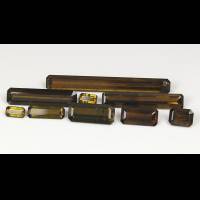Epidote

Sri Lanka
0.52 carats
© Rarestone.com
Relatively large crystals of flawless facet rough are not uncommon, but faceted stones are limited to small sizes and may appear black because of the dark tone of the material.
Epidote Gemstones by Colour
This table shows the variety of hues this gemstone can be found in. Click on a photo for more information.
Epidote Gemstones by Size
This table shows distribution of Epidote gemstone sizes that are listed on this site. This can give a good indication as to the general availability of this gemstone in different sizes.
Contributed photos
Lightest:0.52 cts
Heaviest:15.97 cts
Average:5.27 cts
Total photos:5
Do you have a larger Epidote? Why not upload a photo?
| General Information | ||||||||||||||||||
|---|---|---|---|---|---|---|---|---|---|---|---|---|---|---|---|---|---|---|
| Chemical Formula |
| |||||||||||||||||
| Physical Properties of Epidote | ||||||||||||||||||
| Mohs Hardness | 6 to 7, Blue Chart Gem Identification (2010) More from other references | |||||||||||||||||
| Specific Gravity | 3.25 to 3.50, Blue Chart Gem Identification (2010) More from other references | |||||||||||||||||
| Cleavage Quality | Perfect, Gemmological Tables (2004) More from other references | |||||||||||||||||
| Fracture | Conchoidal,Splintery, Gemstones of the world (2001) More from other references | |||||||||||||||||
| Optical Properties of Epidote | ||||||||||||||||||
| Refractive Index | 1.729 to 1.768, Gemstones of the world (2001) More from other references | |||||||||||||||||
| Optical Character | Biaxial/-, Blue Chart Gem Identification (2010) More from other references | |||||||||||||||||
| Birefringence | 0.014 to 0.045, Blue Chart Gem Identification (2010) More from other references | |||||||||||||||||
| Pleochroism | Orange/brown stones - strong trichroism: green to strong green - light brown to brown - yellow to colorless; Green stones - strong: green - brown - yellow to colorless, Blue Chart Gem Identification (2010) Orange/brown stones - strong: green - brown -yellow to colorlessMore from other references | |||||||||||||||||
| Dispersion | 0.030, Gemstones (2009) | |||||||||||||||||
| Chatoyancy | Rare, Blue Chart Gem Identification (2010) | |||||||||||||||||
| Colour | ||||||||||||||||||
| Colour (General) | Green, yellowish-green, brownish-green, brown, reddish, Gemmological Tables (2004) More from other references | |||||||||||||||||
| Transparency | Transparent, Gemmological Tables (2004) More from other references | |||||||||||||||||
| Lustre | Vitreous, Gemstones (2009) | |||||||||||||||||
| Fluorescence & other light emissions | ||||||||||||||||||
| Fluorescence (General) | None, Gemstones of the world (2001) | |||||||||||||||||
| Crystallography of Epidote | ||||||||||||||||||
| Crystal System | Monoclinic, Blue Chart Gem Identification (2010) More from other references | |||||||||||||||||
| Habit | Prismatic, Gems, Sixth Edition (2006) More from other references | |||||||||||||||||
| Geological Environment | ||||||||||||||||||
| Where found: | Most originate in low- to medium-grade metamorphic rocks., Gems, Sixth Edition (2006) | |||||||||||||||||
| Inclusions in Epidote | ||||||||||||||||||
| Needle-like crystals, distinct growth zoning - Gemmological Tables, Ulrich Henn and Claudio C. Milisenda, 2004, p 21 | ||||||||||||||||||
| Further Information | ||||||||||||||||||
| Mineral information: | Epidote information at mindat.org | |||||||||||||||||
| Significant Gem Localities | ||||||||||||||||||
| ||||||||||||||||||




